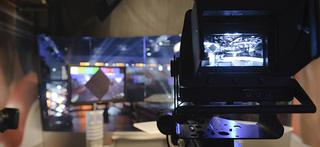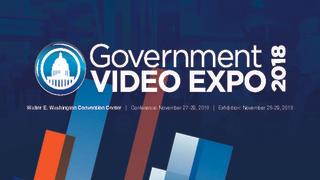Flash Sale! Register Now for SMPTE in D.C.: Essential Technology Advances for Media Pros

At Government Video Expo 2018, the Society of Motion Picture and Television Engineers® (SMPTE®) will be producing an intensive, one-day conference, SMPTE in D.C.
Geared to broadcast and video professionals who want to learn about the latest advances in emerging and potentially transformative video production technologies including high dynamic range (HDR) and the transition to IP.
Through Wednesday, November 21, we are offering a discounted registration price. Member registration, ordinarily $99, is $49. Non-member registration, usually $199, is $99. Use the code SMPTE50 when registering.
Attendees who register for the SMPTE in D.C. conference at Government Video Expo 2018 will receive a free pass to the show, which includes access to 120+ exhibits, free theater sessions and keynote presentations, the Government Learning Symposium, networking events, and more. The cost to attend the SMPTE in D.C. event is $99 for members and $199 for non-members.

To view the SMPTE in D.C. full schedule, click here.
To register to attend, click here.
To view the full Government Video Expo Schedule, click here.
Government Video Expo is held November 28 and 29 at Walter E. Washington Convention Center in Washington, D.C. The event features 32 live free presentations and a free exhibit floor, as well as additional training opportunities. Register here to attend.
To plan your visit, you can download the show guide in advance here.
SMPTE in D.C. Schedule
9–9:30 a.m.
Open, Welcome and an Introduction to Professional Video Over IP
Video over IP networks and the internet has existed for more than two decades. Why is SMPTE developing Studio Video over IP (SVIP)— a new set of standards for video over IP? Why are they needed? What is the difference between streaming video and SVIP?
Peter Wharton, President, Happy Robotz
9:30–10:30 a.m.
High Dynamic Range: The Best TV Picture You've Ever Seen
This HDR presentation will introduce HDR and discuss HDR standards, terminology and the history of dynamic range. The advanced part of the presentation will cover HDR transfer curves and comparing HDR profiles, as well as compatibility with SDR displays and the consumer adoption of UHD HDR TVs.
Although Ultra HD and HDR are usually mentioned together, high-dynamic range is not limited to UHD. HDTV can also benefit from a dramatic improvement in picture quality. HDR offers a more realistic picture, similar to the way we see things in real life. In the future, it’s likely that multiple HDR profiles, optimized for either live TV or postproduced movies, will be utilized.
John Humphrey, Vice President Business Development, Hitachi
10:30–11 a.m.
Break
11 a.m.–12 p.m.
Building Scalable Facilities Using SMPTE 2110
The new set of SMPTE standards (ST 2110) provides a technical underpinning for building large-scale media facilities with uncompromised picture quality and low latency, with scalability to large image formats (4K, 8K and beyond) and advanced color
depths and spaces. This talk is an overview of the new standards, and also covers the practical details of implementing large-scale systems including control APIs and network topology.
John Mailhot, Systems Architect for IP Convergence, Imagine Communications
12–1 p.m.
How Smooth Are Your Packets? Implementation Realities and Best Practices of IP and PTP
This session is a tutorial on what you need to know to understand the challenges we face in the process of making the transition to IP-based transport for video, audio and data. This move toward infrastructure efficiency has brought new technical challenges requiring broadcast engineers to gain an understanding of the technology and the latest techniques needed to monitor these signals.
The development of SMPTE ST 2110 is a suite of standards that provide encapsulation of uncompressed video within IP packets and for live IP production carrying separate streams of video, audio and data packets. This new standard also allows for SMPTE ST 2022-6 that provides encapsulation of uncompressed SDI as well as ST 2059 for system timing.
This session will take a look at the basic structure of the packets for ST 2022 and ST 2110, how variable delay across the network introduces jitter at the receiver and how measurements can be made on the stream. Latency in the network can produce out-of-order packets or corruption of the data causing packets to be dropped. Therefore, it is important to monitor the stream to ensure an error-free network to ensure transmission of the high bit rate media and how these errors affect the actual video and audio signal.
For redundancy in the media network, SMPTE ST 2022-7 can be used to provide a Path One and a Path Two stream so that the downstream device can determine which path is the most appropriate to use. Measurement of the integrity of both paths is important and we will look at ways of monitoring the signal paths.
Karl Kuhn, Sr. Field Video Application Engineer, Tektronix
1–2 p.m.
Lunch
2–3 p.m.
Myths and Realities of Security of Professional Media Over Managed IP Networks
It seems that nearly every day there is another story about an IP network breach. Now "they" want to build professional media creation facilities with IP at the core? What are the risks? And, are the risks as bad as "they" say? Find out the facts about IP network security in this must-see SMPTE session.
Thomas Bause Mason, Director Standards Development, SMPTE
3–4 p.m.
The People Side: Managing Change and Skills Transition
The accelerating pace of technological change requires an increased focus on an organization's top resource — its people. This presentation will provide insights, practical approaches and tools for managing change, building and retaining a diverse and inclusive workforce.
John McCoskey, Industry Executive, Eagle Hill Consulting - Technology, Media & Entertainment
Get the TV Tech Newsletter
The professional video industry's #1 source for news, trends and product and tech information. Sign up below.
